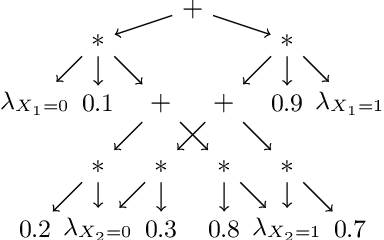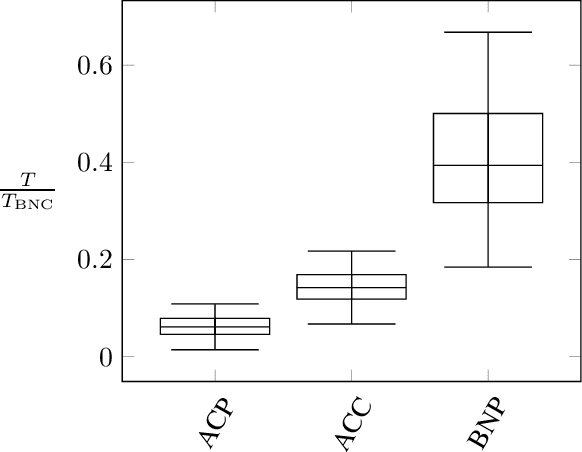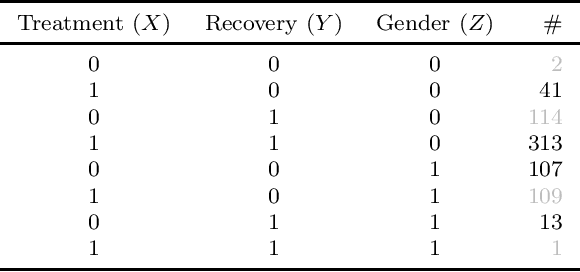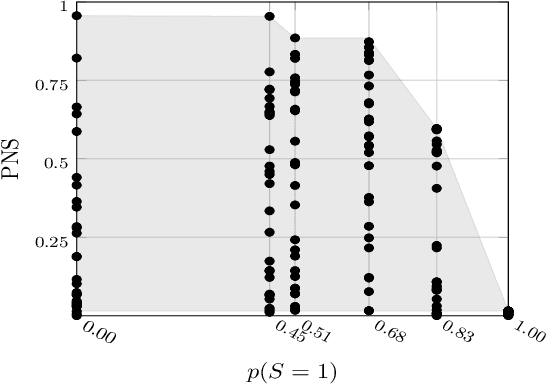David Huber
Tractable Bounding of Counterfactual Queries by Knowledge Compilation
Oct 05, 2023



Abstract:We discuss the problem of bounding partially identifiable queries, such as counterfactuals, in Pearlian structural causal models. A recently proposed iterated EM scheme yields an inner approximation of those bounds by sampling the initialisation parameters. Such a method requires multiple (Bayesian network) queries over models sharing the same structural equations and topology, but different exogenous probabilities. This setup makes a compilation of the underlying model to an arithmetic circuit advantageous, thus inducing a sizeable inferential speed-up. We show how a single symbolic knowledge compilation allows us to obtain the circuit structure with symbolic parameters to be replaced by their actual values when computing the different queries. We also discuss parallelisation techniques to further speed up the bound computation. Experiments against standard Bayesian network inference show clear computational advantages with up to an order of magnitude of speed-up.
Approximating Counterfactual Bounds while Fusing Observational, Biased and Randomised Data Sources
Jul 31, 2023Abstract:We address the problem of integrating data from multiple, possibly biased, observational and interventional studies, to eventually compute counterfactuals in structural causal models. We start from the case of a single observational dataset affected by a selection bias. We show that the likelihood of the available data has no local maxima. This enables us to use the causal expectation-maximisation scheme to approximate the bounds for partially identifiable counterfactual queries, which are the focus of this paper. We then show how the same approach can address the general case of multiple datasets, no matter whether interventional or observational, biased or unbiased, by remapping it into the former one via graphical transformations. Systematic numerical experiments and a case study on palliative care show the effectiveness of our approach, while hinting at the benefits of fusing heterogeneous data sources to get informative outcomes in case of partial identifiability.
Efficient Computation of Counterfactual Bounds
Jul 17, 2023Abstract:We assume to be given structural equations over discrete variables inducing a directed acyclic graph, namely, a structural causal model, together with data about its internal nodes. The question we want to answer is how we can compute bounds for partially identifiable counterfactual queries from such an input. We start by giving a map from structural casual models to credal networks. This allows us to compute exact counterfactual bounds via algorithms for credal nets on a subclass of structural causal models. Exact computation is going to be inefficient in general given that, as we show, causal inference is NP-hard even on polytrees. We target then approximate bounds via a causal EM scheme. We evaluate their accuracy by providing credible intervals on the quality of the approximation; we show through a synthetic benchmark that the EM scheme delivers accurate results in a fair number of runs. In the course of the discussion, we also point out what seems to be a neglected limitation to the trending idea that counterfactual bounds can be computed without knowledge of the structural equations. We also present a real case study on palliative care to show how our algorithms can readily be used for practical purposes.
Learning to Bound Counterfactual Inference in Structural Causal Models from Observational and Randomised Data
Dec 06, 2022Abstract:We address the problem of integrating data from multiple observational and interventional studies to eventually compute counterfactuals in structural causal models. We derive a likelihood characterisation for the overall data that leads us to extend a previous EM-based algorithm from the case of a single study to that of multiple ones. The new algorithm learns to approximate the (unidentifiability) region of model parameters from such mixed data sources. On this basis, it delivers interval approximations to counterfactual results, which collapse to points in the identifiable case. The algorithm is very general, it works on semi-Markovian models with discrete variables and can compute any counterfactual. Moreover, it automatically determines if a problem is feasible (the parameter region being nonempty), which is a necessary step not to yield incorrect results. Systematic numerical experiments show the effectiveness and accuracy of the algorithm, while hinting at the benefits of integrating heterogeneous data to get informative bounds in case of unidentifiability.
Bounding Counterfactuals under Selection Bias
Jul 26, 2022



Abstract:Causal analysis may be affected by selection bias, which is defined as the systematic exclusion of data from a certain subpopulation. Previous work in this area focused on the derivation of identifiability conditions. We propose instead a first algorithm to address both identifiable and unidentifiable queries. We prove that, in spite of the missingness induced by the selection bias, the likelihood of the available data is unimodal. This enables us to use the causal expectation-maximisation scheme to obtain the values of causal queries in the identifiable case, and to compute bounds otherwise. Experiments demonstrate the approach to be practically viable. Theoretical convergence characterisations are provided.
Matching Representations of Explainable Artificial Intelligence and Eye Gaze for Human-Machine Interaction
Jan 30, 2021



Abstract:Rapid non-verbal communication of task-based stimuli is a challenge in human-machine teaming, particularly in closed-loop interactions such as driving. To achieve this, we must understand the representations of information for both the human and machine, and determine a basis for bridging these representations. Techniques of explainable artificial intelligence (XAI) such as layer-wise relevance propagation (LRP) provide visual heatmap explanations for high-dimensional machine learning techniques such as deep neural networks. On the side of human cognition, visual attention is driven by the bottom-up and top-down processing of sensory input related to the current task. Since both XAI and human cognition should focus on task-related stimuli, there may be overlaps between their representations of visual attention, potentially providing a means of nonverbal communication between the human and machine. In this work, we examine the correlations between LRP heatmap explanations of a neural network trained to predict driving behavior and eye gaze heatmaps of human drivers. The analysis is used to determine the feasibility of using such a technique for enhancing driving performance. We find that LRP heatmaps show increasing levels of similarity with eye gaze according to the task specificity of the neural network. We then propose how these findings may assist humans by visually directing attention towards relevant areas. To our knowledge, our work provides the first known analysis of LRP and eye gaze for driving tasks.
 Add to Chrome
Add to Chrome Add to Firefox
Add to Firefox Add to Edge
Add to Edge